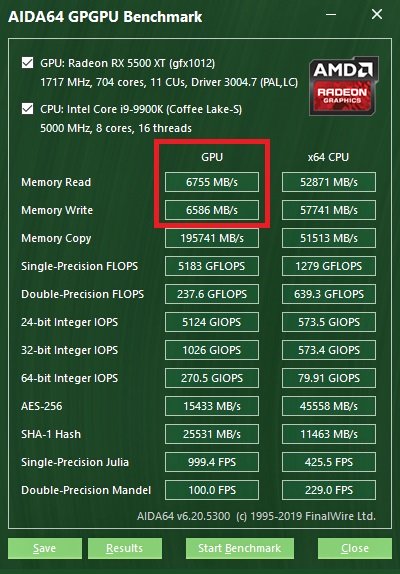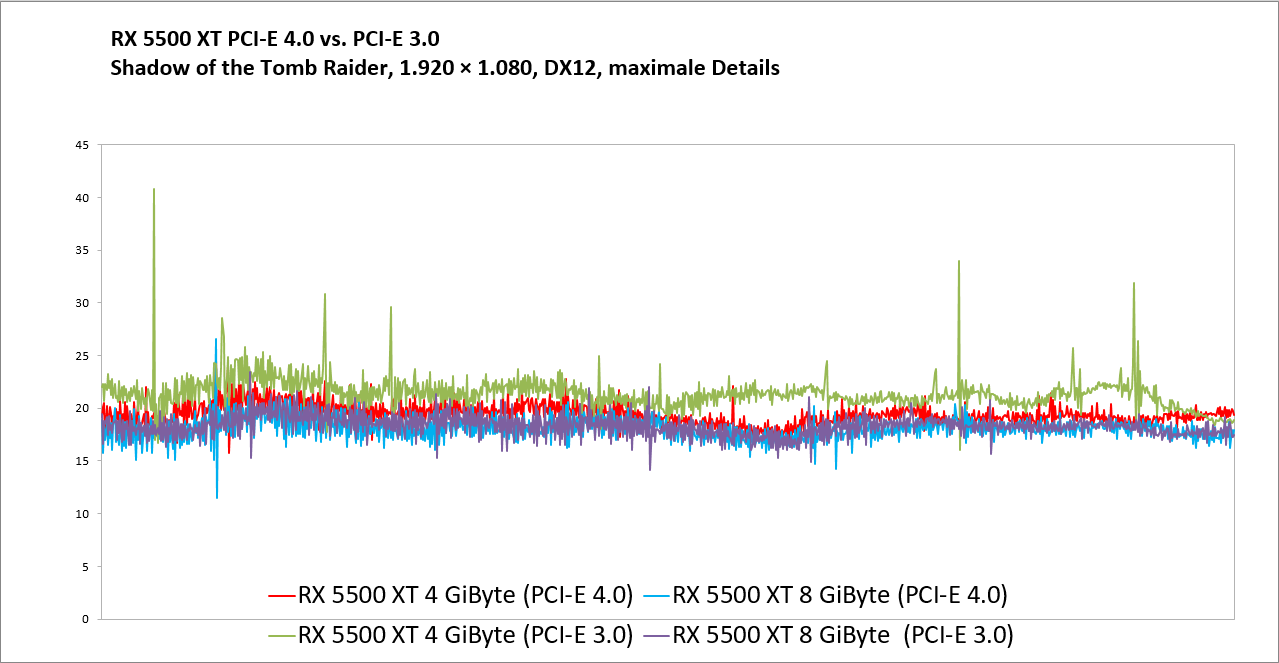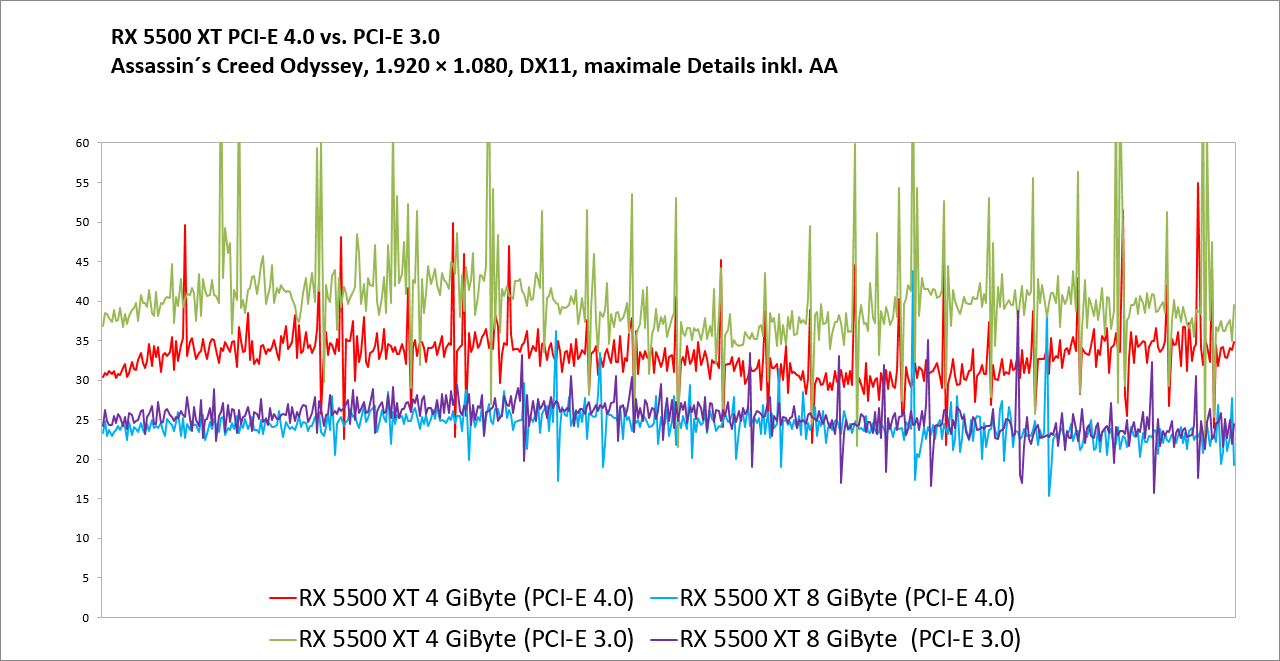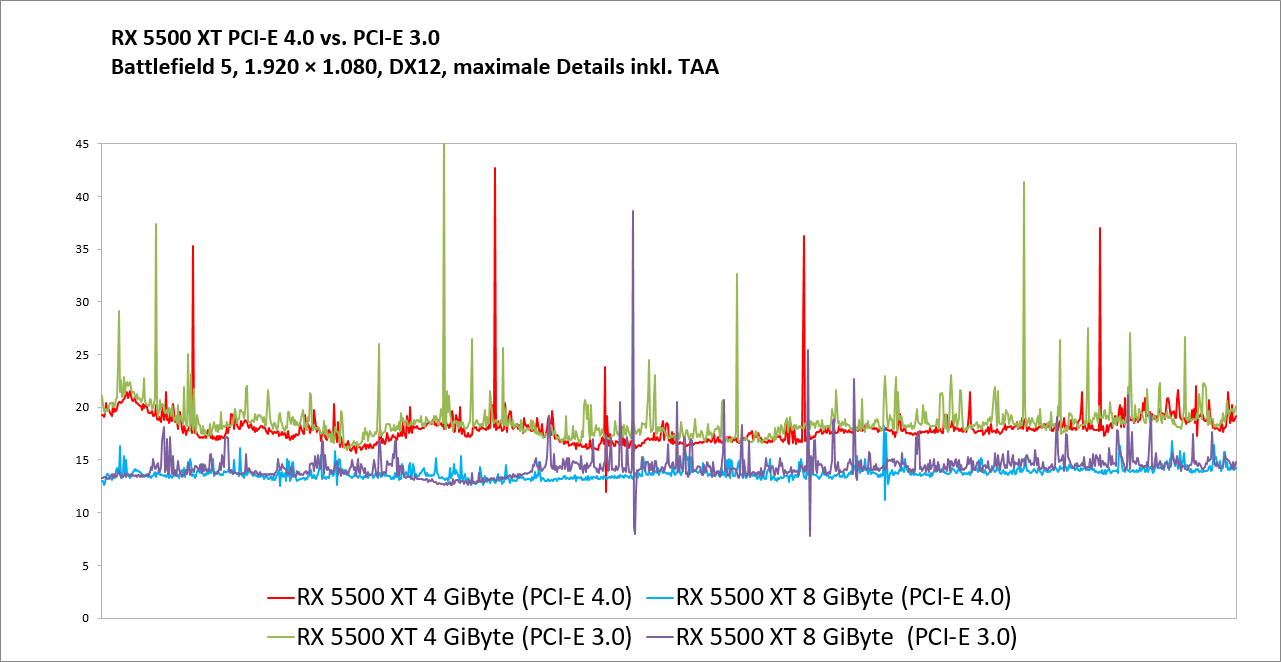Is AMD’s Radeon RX 5500 XT Hamstrung by VRAM and PCIe Bandwidth?
A German site's testing showed the 4GB version running significantly faster with PCIe 4.0.
With the release of the budget RX 5500 XT, AMD started to fill out the bottom two-thirds of its product stack, bringing much-needed competition into that segment. The graphics card arrived with 4GB and 8GB variants ($169 and $199 respectively), and in our RX 5500 XT review, some titles--namely Forza Horizon 4, Battlefield V, Far Cry 5 and Shadow of the Tomb Raider--the 4GB variant performed considerably slower when running Ultra settings. The initial takeaway from this was the 4GB capacity is simply not enough for those titles, which is correct. However, there's more to it.
German website pcgameshardware.de recently tested both RX 5500 XT versions using PCIe 3.0 and PCIe 4.0. The results were a bit surprising. They found that when the 4GB card's VRAM buffer was full, running on a PCIe 4.0 slot improved performance by reducing the impact of using VRAM. The 8GB also displayed minor improvements from PCIe 3.0 to 4.0, but the 8GB capacity is what makes that card shine, since the extra memory means the card didn't have to dump data off of the faster VRAM as often.
So why does this happen? Once the VRAM is filled up, the extra data is sent to the system RAM across the PCIe bus. The faster the bus, the faster the swapped data will get where it needs to go and not delay the next frame. The 5500 XT is wired as a PCIe 4.0 x8 card (physical tab is x16), which yields the same theoretical bandwidth as PCIe 3.0 x16. According to the article, AMD said that is sufficient for a GPU of this performance class. For all intents and purposes, this is correct. However, for games that eclipse the installed VRAM we see it can fall short.


What pcgameshardware.de showed was that during memory reads and writes, the transfer rate was effectively cut in half. Whereas PCIe 4.0 x16 would reach 12.5 GBps, x8 only reaches around 6.5-6.7 GBps -- half the throughput. Memory copy speeds are not affected, as this is the transfer rate from the memory itself.
So what does this mean for performance? The improvements varied by title (and settings), but pcgameshardware.de tested Assassin’s Creed Odyssey, Battlefield V, Far Cry: New Dawn, Wolfenstein Youngblood and Shadow of the Tomb Raider. In each test, there were improvements in the 4GB card when it was running on a PCIe 4.0 system. Some were significant, others not so much. Assassin's Creed and Far Cry appeared to benefit the most, along with Wolfenstein Youngblood. The 8GB variant also showed slight improvements across the board, but not nearly as much.




In the end, it's a curious choice for AMD to wire these cards in an x8 configuration, particularly with the 4GB card, which has a greater chance of running into VRAM limits. While many titles will not run into these issues, those that do can take a severe performance hit.
With all of this information, I’m left wondering why AMD chose to configure the card in this manner? Cost perhaps? Increasing the performance of both cards can only help the optics, especially on the 4GB card, which is the most affected. This could have been spun as a reason to buy into the AMD Ryzen 3000 X570 ecosystem as a bright spot for PCIe 4.0. But instead, we are left wondering, why?
Get Tom's Hardware's best news and in-depth reviews, straight to your inbox.

Joe Shields is a staff writer at Tom’s Hardware. He reviews motherboards and PC components.
-
tennis2 Have there been other GPUs that are wired as x8? Or is this the beginning of a new trend?Reply -
logainofhades Most reviews, that I have watched, have said skip the 8gb version, so a bit confused was to why it keeps getting recommended.Reply -
tennis2 Perhaps Tom's should retest and update their initial review since they used a PCIe 3.0 system.Reply -
InvalidError Reply
Most sites recommend the 4GB model over the 8GB one simply because by the time most games run out of VRAM on 4GB, the RX5500's 1% lows are already well under 60fps (starting to get noticeably stuttery) and you will probably want to reduce details anyway.logainofhades said:Most reviews, that I have watched, have said skip the 8gb version, so a bit confused was to why it keeps getting recommended. -
TechyInAZ Replytennis2 said:Have there been other GPUs that are wired as x8? Or is this the beginning of a new trend?
Yes there have been, but they've always been very low tier cards, below $100 like the Nvidia GT cards.
This is very strange for AMD to do, on a card that is an actual gaming card. It doesn't make much sense either in my opinion, because A. What Tom's Hardware was talking about with it adding more horsepower to games and B. Most 5500 XT's are going to be slotting into budget PCI-E 3.0 boards. Not 4.0 boards, which means 3.0 x8 bandwidth is the max you'll get for these cards instead of 3.0 x16. -
InvalidError Reply
Even if the GPU had 4.0x16, that's still only 32GB/s peak at 200+ns of latency for system RAM overflow vs 224GB/s at 60ns worst-case latency for VRAM, the performance would still suffer horribly once you exceed the 4GB on-board. The only real option is to reduce details to get the game to fit comfortably within 4GB of VRAM assuming you didn't already have to reduce graphics details just to hit steady 60+fps before hitting 100% shader load regardless of VRAM usage.TechyInAZ said:Most 5500 XT's are going to be slotting into budget PCI-E 3.0 boards. Not 4.0 boards, which means 3.0 x8 bandwidth is the max you'll get for these cards instead of 3.0 x16. -
rostrow416 Chances are, if you are shelling out for an X570 board and 3rd gen Ryzen CPU, this GPU probably wouldn't be high up on your list of choices. Its more likely to be an upgrade for older or budget systems, which will be PCIE 3.0 anyway.Reply -
larkspur Wow... This is disturbing! I likely won't be on PCI 4.0 for awhile and expect my GAMING GPU to use the 16 lanes of PCI 3.0 that I give it. Has this been fully verified Joe? I know the 5500 XT is lower-tier by today's standards but it is marketed as a value GAMING card... what's going on here? Does AMD expect me to pickup a new mobo/cpu just to FULLY utilize its newest card?Reply
Invalid Error - Yeah, I guess going with the overpriced 8gb version makes even more sense for those of us still using PCI 3.0... But more and more I honestly think I may go Nvidia this time... this article has me thinking that AMD might have really messed this up :( Can anyone confirm this whole wired for only 8-lanes thing?
Just to sum up the crux of my concern: When you WIRE a card for x8 PCI 4.0 lanes, when you plug it into a PCI 3.0 system - it can still only use 8 lanes of PCI 3.0 even if 16 lanes are available. Is that correct? -
TJ Hooker Reply
If you're running out of VRAM your performance is going to tank regardless of whether it's running PCIe 3.0 or 4.0. Take a look at the results: the 4GB card may run better on PCIe 4.0, but it's still much worse than the 8GB card. Plus cranking up your settings to the point where you need >4GB of VRAM is probably going to result in poor regardless performance due to the GPU itself.larkspur said:Invalid Error - Yeah, I guess going with the overpriced 8gb version makes even more sense for those of us still using PCI 3.0... But more and more I honestly think I may go Nvidia this time... this article has me thinking that AMD might have really messed this up :( Can anyone confirm this whole wired for only 8-lanes thing?
Yes, the card only has a x8 interface. I do think it would have been better for this card to have a x16 interface, but I don't think it's going to be a make or break thing in real world usage -
larkspur Reply
Heh, well I'm in the market for a new card and clearly this isn't it. It reminds me of the 3.5gb GTX 970 fiasco where nvidia should have just been up front about it instead of everyone finding out only after some clever people figured it out. And yes - the card's performance in the reviews didn't change. But Nvidia tried to sneak it under the radar like apparently AMD is doing with this card and its sub-optimal x8 PCI wiring (I assume we'll hear a response soon).TJ Hooker said:If you're running out of VRAM your performance is going to tank regardless of whether it's running PCIe 3.0 or 4.0. Take a look at the results: the 4GB card may run better on PCIe 4.0, but it's still much worse than the 8GB card. Plus cranking up your settings to the point where you need >4GB of VRAM is probably going to result in poor regardless performance due to the GPU itself.
I don't speak German, but that article makes it pretty clear that there are significant differences between running PCI 3.0 with both versions of the 5500 XT - magnified especially with the 4gb version (which all kinds of value-seekers running PCI 3.0 will buy)... This decision to go with x8 lanes seems absolutely ridiculous... it hurts the value-seekers that would buy this card and use it on a PCI 3.0 system... I mean, come on do they actually expect most people in this price range to be using the newest ryzen/threadripper MOTHERBOARDS? That's why I'm wondering if this whole thing has been tested extensively and verified and applies to all of the 5500 XTs?. I just don't see AMD screwing up this card this badly...